Difference between revisions of "Fissidens crispus"
Ann. Sci. Nat., Bot., sér. 2, 9: 57. 1838,.
FNA>Volume Importer |
FNA>Volume Importer |
||
| Line 10: | Line 10: | ||
|name=Fissidens limbatus | |name=Fissidens limbatus | ||
|authority=Sullivant | |authority=Sullivant | ||
| + | |rank=species | ||
}} {{Treatment/ID/Synonym | }} {{Treatment/ID/Synonym | ||
|name=Fissidens limbatus var. brevifolius | |name=Fissidens limbatus var. brevifolius | ||
|authority=(Cardot & Thériot) Grout | |authority=(Cardot & Thériot) Grout | ||
| + | |rank=variety | ||
}} {{Treatment/ID/Synonym | }} {{Treatment/ID/Synonym | ||
|name=Fissidens limbatus var. ensiformis | |name=Fissidens limbatus var. ensiformis | ||
|authority=Grout | |authority=Grout | ||
| + | |rank=variety | ||
}} {{Treatment/ID/Synonym | }} {{Treatment/ID/Synonym | ||
|name=Fissidens pusillus var. brevifolius | |name=Fissidens pusillus var. brevifolius | ||
|authority=Cardot & Thériot | |authority=Cardot & Thériot | ||
| + | |rank=variety | ||
}} {{Treatment/ID/Synonym | }} {{Treatment/ID/Synonym | ||
|name=Fissidens repandus | |name=Fissidens repandus | ||
| − | |authority= | + | |authority= |
| + | |rank=species | ||
}} {{Treatment/ID/Synonym | }} {{Treatment/ID/Synonym | ||
|name=Fissidens tortilis | |name=Fissidens tortilis | ||
| − | |authority= | + | |authority= |
| + | |rank=species | ||
}} | }} | ||
|hierarchy=Fissidentaceae;Fissidens;Fissidens crispus | |hierarchy=Fissidentaceae;Fissidens;Fissidens crispus | ||
| Line 48: | Line 54: | ||
-->{{#Taxon: | -->{{#Taxon: | ||
name=Fissidens crispus | name=Fissidens crispus | ||
| − | |||
|authority=Montagne | |authority=Montagne | ||
|rank=species | |rank=species | ||
| Line 61: | Line 66: | ||
|publication year= | |publication year= | ||
|special status= | |special status= | ||
| − | |source xml=https://jpend@bitbucket.org/aafc-mbb/fna-data-curation.git/src/ | + | |source xml=https://jpend@bitbucket.org/aafc-mbb/fna-data-curation.git/src/f50eec43f223ca0e34566be0b046453a0960e173/coarse_grained_fna_xml/V27/V27_484.xml |
|genus=Fissidens | |genus=Fissidens | ||
|species=Fissidens crispus | |species=Fissidens crispus | ||
Revision as of 21:02, 16 December 2019
Plants to 10 × 3 mm. Stem unbranched and branched; axillary hyaline nodules absent; central strand present or absent. Leaves as many as 20 pairs, elliptic to broadly lanceolate to oblong-lingulate, acute, short-acuminate to obtuse-apiculate, to 2 × 0.5 mm; dorsal lamina narrowed proximally, ending before insertion to ± decurrent; vaginant laminae 2/3–3/4 leaf length, equal; margin ± entire but usually serrulate distally, limbate on all laminae, limbidium usually ending a few cells before apex, frequently edged by 1–2 rows of quadrate to oblong chlorophyllose cells in proximal parts of vaginant laminae, limbidial cells 1–2-stratose; costa percurrent to ending 2–5 cells before leaf, infrequently short-excurrent, bryoides-type; laminal cells 1-stratose, smooth, strongly bulging, densely chlorophyllose, ± obscure, firm-walled, irregularly quadrate to hexagonal, usually arranged in discernable rows in distal part of leaf, 6–10 µm, twice as deep as wide. Sexual condition gonioautoicous and rhizautoicous. Sporophytes 1–2 per perichaetium. Seta to 9 mm. Capsule theca exserted, inclined, bilaterally symmetric to erect, radially symmetric, to 1 mm; peristome bryoides-type; operculum 0.5 mm. Calyptra cucullate, smooth, 0.8 mm. Spores 10–16 µm.
Habitat: Moist shaded soil, over rocks near streams, infrequently submerged by fluctuating water levels
Distribution

Alta., B.C., Ariz., Calif., Colo., La., Miss., Nev., N.Mex., Oreg., Tex., Utah, Wash., Mexico, West Indies, Central America, South America.
Discussion
Three species belong to the Fissidens crispus complex; F. crispus, F. minutulus, and F. sublimbatus. A well-developed limbidium and small (6–10 µm), bulging, obscure laminal cells that in transverse section are twice as deep as wide characterize all three.
Fissidens crispus, better known in western North America as F. limbatus, is highly variable and widespread, ranging widely in tropical America, where it also attains its greatest variability. It is best distinguished by laminal cells that are usually arranged in discernable rows in the distal parts of leaves. The dorsal lamina is quite variable, ending above the insertion to long-decurrent as in some tropical expressions. Leaves, when dry, are usually crispate. The limbidium is found on all or most leaves and usually extends to or ends just before the apex.
Selected References
None.